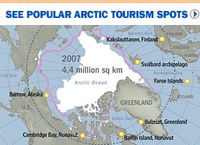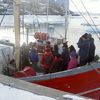Færsluflokkur: Ferðalög
28.11.2007 | 18:57
Máttur SKYPE og alþjóðlegir endurfundir vina úr öllum heimsálfum.
Jedúddamía. Ef ég hefði verið uppi fyrir 10 árum, 15 árum eða fyrr og ekki í dag hefði ég ekki upplifað mátt skype. Gamall vinur minn frá Brasilíu hafði allt í einu samband við mig í dag. Ég hef ekki talað við hann í fimm ár eða síðan að við eyddum viku saman í höll Rockefeller í Bellagio við Como vatnið á Norður Ítalíu. Það var hópur fólks frá 23 löndum sem hittust þá en öll áttum við það sameiginlegt að vera að vinna í verkefni um grænkortagerð. Ég skammast mín verulega er ein af fáum sem ekki hef enn gefið út kortið mitt, en ég hef notað það og aðferðina í kennslu. Aðal markmið verkefnisins er svo sem ekki að gefa út kort, heldur fremur að eiga þátt í að breyta hugsunarhætti fólks um borgarumhverfi sitt.
Leon er frá Sao Paulo og hefur notað verkefnið til að kenna börnum í fátækrahverfum sem sum hver eru ekki læs, að horfa á nærumhverfi sitt með væntumþykju-augum, fá fólk til að rækta jörðina. Allt út frá hugsuninni um að elski maður eitthvað, þá vill maður bæta það og passa uppá. Við vorum einmitt að ákveða að skrifa saman greinar á nýja árinu, það verður gaman.
Nú ætlum við félagarnir að blása til endurfundar í gegnum skype. Þetta er hreinlega frábær tækni. Við munum vera frá Íslandi, Brasilíu, Japan, Bandaríkjunum, Kanada, Noregi, Svíþjóð, Þýskalandi, Rúmeníu, , Austurríki og fleiri löndum að tala saman.
Ferðalög | Slóð | Facebook | Athugasemdir (6)
19.11.2007 | 15:45
Breskir gistihúsaeigendur í vandræðum vegna gesta sem ganga í svefni
Vinir sonar míns halda úti alternatívri fréttasíðu. Hana er gaman að glugga í ef manni leiðist og langar að hlæja aðeins.
Flestar fréttirnar eru réttar en ýktar. Sjá annars http://kupje.com/
Þessi birtist um daginn. Aumingja gistihúsaeigendur á Bretlandi!
Hotelkæde i problemer grundet nøgne søvngængere
Onsdag d. 7. november 2007, kl. 08:07 - Skrevet af Esben Knudsen
En hotelkæde i Storbritanien har følt sig tvunget til at genuddanne deres ansatte da de flere gange har oplevet af deres elskede gæster gik i søvne, nøgne.
Hotelkæden udtaler ydermere at de fleste nøgne søvngængere er mænd.
Det må godt nok være nederen af vågne op og så stå nøgen midt i den fineste restaurant på hotellet, med en sygeligt skrumper på.
Ferðalög | Breytt s.d. kl. 15:47 | Slóð | Facebook | Athugasemdir (3)
15.11.2007 | 17:24
Hvað er sjávartengd ferðamennska?
Sjávartengd ferðamennska/ferðaþjónusta á hug minn mestan um þessar mundir. Ég varð þess heiðurs aðnjótandi að fá að skilgreina fyrirbrigðið á vísindavef Háskólans. Það sem ég hlakka þó talsvert til er að ég ásamt öðru góðu fólki og fulltrúum frá Leeds Metropolitan University er að skipuleggja alþjóðlega ráðstefnu um sjávartengda ferðamennsku sem haldin verður við Háskóla Íslands mánaðarmótin febrúar-mars á næsta ári.
Við vitum auðvitað ekki umfang ráðstefnunnar en sem komið er, þar eð frestur til að skila inn ágripum rennur fyrst út um miðjan desember. En í bili er bara að boða fagnaðarerindið og geri ég það hérmeð.
International Conference: Journeys of Expression VII: Celebrating the Edges of the World: Tourism and Festivals of the Coast and Sea

Ferðalög | Breytt s.d. kl. 17:25 | Slóð | Facebook | Athugasemdir (5)
3.11.2007 | 17:15
Við Elías í Barcelona
Við mæðgin fórum til Barcelona saman, ég að kenna við Universitát Autonoma de Barcelona, og hann sem minn aðstoðarmaður. Við lentum heldur betur illa í því við vorum rænd fyrsta kvöldið![]()
Hér eru nokkur brot úr dagbókum sonar míns sem að hann skrifaði fyrir bekkinn sinn í utanlandsdvölinni.![]()
Fyrsta kvöldið okkar í Barcelona urðum við fyrir óhappi. Eftir að hafa skoðað Dali safnið, stoppuðum við á Tapas bar við Dómkirkjutorgið sem´hét Bilbao eins og borgin í Baskalandi. Á meðan ég var að ná í tapas var töskunni hennar mömmu stolið. Mamma sat allann tímann á sama bekknum með töskuna við hliðina á sér. Við leituðum um allt og fólkið á staðnum hafði mikla samúð með okkur. Við vorum ráðþrota. Tvær þýskar konur gáfu okkur tvær og hálfa evru svo við kæmumst með lestinni á hótelið okkar. Við fórum á lögreglustöðina![]() og vorum þar til miðnættis (fjórar klukkustundir), á meðan að mamma var að skrifa skýrslur og loka kortum. Ég sofnaði næstum í gluggakistunni á meðan.
og vorum þar til miðnættis (fjórar klukkustundir), á meðan að mamma var að skrifa skýrslur og loka kortum. Ég sofnaði næstum í gluggakistunni á meðan.
Ég var með mömmu í háskólanum. Nemendurnir voru ekki bara að hlusta á mömmu. Það voru stelpur að biðja mig um að teikna fyrir sig. Við fórum í matarboð heim til Fransesc. Konan hans sem heitir Helena gaf mér Fouet, sem er rosalega góð katalónsk pylsa. Hún kenndi mér katalónsku, að segja: Bono tarde, amdic Elias.
Við fórum að hitta Bíbí á Placa Catalunya. Við gengum með henni á aðal ferðamannagötunni sem heitir Rambla. Þar er mikið af fólki klætt í skrýtna búninga og stendur eins og styttur. Þar eru líka listamenn að teikna myndir af fólki. Ég heimsótti skólann hans Hjálmars. Hann heitir Colegi Sagrada Familia![]() einu sinni var skólinn hans allur nunnuskóli
einu sinni var skólinn hans allur nunnuskóli![]() . En það var í gamla daga
. En það var í gamla daga![]() .
.
Hjálmar er í öðrum bekk. Það er bara einn bekkur í hverjum árgang. Hjálmar er að læra lestur, stærðfræði, listasmiðju, spænsku, ensku, tölvur, ritun, kristinfræði og lífsleikni ásamt tónmennt. Matartíminn í skólanum er langur. Hann er milli 13 og 15 á hverjum degi. Skólastjórinn sem hét Carma fór með okkur í skoðunarferð um skólann. Hann er á mörgum hæðum og næstum eins og völundarhús![]()
![]()
Skólinn er frá 9-17 á daginn. Hjálmar lærir munnlega tjáningu á föstudögum. Honum finnst öll fög jafn skemmtileg í skólanum. Mér finnst listasmiðja skemmtilegust![]()
![]()
![]()
Eftir heimsóknina lékur við okkur fram á kvöld. Svo fórum við á Pizza stað![]()
Ferðalög | Slóð | Facebook | Athugasemdir (0)
30.10.2007 | 21:51
Til sóknar gegn Guantánamo!!
Ég er farin til sjós! Búin að melda mig í áhöfnina um borð í Flotilla. Þar er stór áhöfn. Hún telur tugi þúsunda fólks frá öllum heimsálfum sem að hafa sett sér að markmiði að loka Guantanamo fangelsinu - alls 31.752 manns. Íslendingar hafa verið duglegir að melda sig í áhöfn - 503 Íslendingar hafa skráð sig til ferðarinnar. En einungis 33 Rússar bara svona til að nefna dæmi. Þetta er verðugt átak á vegum Amnesty International.
Ég fékk póst í vikunni frá þeim með eftirfarandi boðum.
Close Guantánamo flotilla crossing the sea - full steam ahead!
Hello all travellers!
I am Sarah, a crewmember onboard the Close Guantánamo flotilla!
Thanks to you, our flotilla is going full steam ahead. You have now reached the
second stage of this expedition and you are getting closer to Guantánamo.
It’s been amazing to see the support that the campaign to close Guantánamo is
gathering. Thousands of people from all over the world are travelling with us and
more and more people are joining the flotilla each day.
Also, on terra firma, there have been waves of protests against the detention
facility. You can read more about Close Guantánamo actions around the world in our
blog.
And of course, it’s not over yet. There’s still a long way to go and we need as
many people as possible on board. Please send this email to your friends and ask
them to join the Close Guantánamo flotilla.
Surfers, pirates, mermaids, sailors, dolphin riders… have a good trip!
Sarah BurtonCampaigns Programme Director
Og til annarra sem gætu haft áhuga á förinni fyrirheitnu!
http://amnesty.textdriven.com/guantanamo/home/
Ferðalög | Slóð | Facebook | Athugasemdir (3)
28.10.2007 | 23:47
Góð helgi í Húsafelli
Ferðalög | Slóð | Facebook | Athugasemdir (0)
9.10.2007 | 18:56
Friðarsúlan og hráslaginn.
Ferðalög | Slóð | Facebook | Athugasemdir (0)
3.10.2007 | 17:05
Toppurinn á tilverunni sífellt vinsælli fyrir hverfulleika
 Mér barst póstur frá Miriam Geitz vinkonu minni. Hún sendi mér grein úr Wall Street Journal um hvernig ferðamennska er að breytast á norðurhveli og sífellt fleiri ferðamenn laðast að ferðalögum norður um slóðir (og á Suðurskautslandið) fyrir þær sakir að þar gætir meiri hverfulleika í náttúrufari vegna ýktari loftslagsbreytinga en annars staðar. Greinin er að mörgu leyti áhugaverð, en þar gætir líka svolítillar "sensation" umfjöllunar um Ilullisat á Grænlandi. Ég held að greinarhöfundar hafi á réttu að standa að hverfulleiki jöklanna laðar að og við höfum fyrir því vissu á síðustu árum. En aðeins er um stutt tímabil á ári að ræða þar sem sýnileiki bráðnunar er svona hraður. Eins og Einar Sveinbjörnsson benti réttilega á er aukin aðgengileiki um hafið norðan við Grænland/sjóleiðin aðeins opin mjög skamman tíma árs. Á öðrum tímum árs eru veður óútreiknanleg.
Mér barst póstur frá Miriam Geitz vinkonu minni. Hún sendi mér grein úr Wall Street Journal um hvernig ferðamennska er að breytast á norðurhveli og sífellt fleiri ferðamenn laðast að ferðalögum norður um slóðir (og á Suðurskautslandið) fyrir þær sakir að þar gætir meiri hverfulleika í náttúrufari vegna ýktari loftslagsbreytinga en annars staðar. Greinin er að mörgu leyti áhugaverð, en þar gætir líka svolítillar "sensation" umfjöllunar um Ilullisat á Grænlandi. Ég held að greinarhöfundar hafi á réttu að standa að hverfulleiki jöklanna laðar að og við höfum fyrir því vissu á síðustu árum. En aðeins er um stutt tímabil á ári að ræða þar sem sýnileiki bráðnunar er svona hraður. Eins og Einar Sveinbjörnsson benti réttilega á er aukin aðgengileiki um hafið norðan við Grænland/sjóleiðin aðeins opin mjög skamman tíma árs. Á öðrum tímum árs eru veður óútreiknanleg.
Arctic Becomes Tourism Hot Spot, But Is That Cool?
Interest in Global Warming Is Now a Selling Point; Seeing Glaciers 'Calve'
By GAUTAM NAIK
September 24, 2007; Page A1
DISKO BAY, Greenland -- James Brusslan is an environmental lawyer with climate
change on his mind. He cycles to the office and works at a Chicago law firm that
offsets its carbon emissions. He plasters friends' SUVs with stickers that say: "I'm
changing the climate! Ask me how!"
<http://online.wsj.com/public/resources/documents/info-arctictourism0709.html>
To get a first-hand glimpse of such changes, Mr. Brusslan, 50 years old, recently
spent $2,800 on a week's camping trip here, about 200 miles north of the Arctic
Circle. "I wanted to see what was happening," he said, as he gazed at an ice fiord
where a glacier was splintering into icebergs. "In 10 years, it probably will be
gone." He next plans to see the melting glaciers of Sichuan, China.
Global warming has given rise to a new niche in the booming eco-tourism business:
climate tourists. These visitors seek out places where a long-term warming trend --
subject of a global summit hosted by the United Nations this week -- is starting to
have a discernible impact. Yet some say there's a big irony in this kind of travel:
Any trip by train, plane or cruise ship pumps carbon dioxide into the atmosphere and
potentially contributes to the warming of the planet.
"What's the point of your trip to the Maldives if the end result is that it will be
drowned" because emissions from eco-tourists' jets contribute to global warming and
rising seas, says Jeff Gazzard of Aviation Environmental Federation, a United
Kingdom group fighting to curtail airplane emissions. The Maldives, a string of
islands in the Indian Ocean, sit about three feet above sea level and are at risk if
warming effects raise ocean levels.
More than 1.5 million tourists now visit the arctic each year, up from one million
in the early 1990s, according to the U.N. Longer and warmer summers keep arctic seas
freer of ice flows, so cruise ships can visit places that were once inaccessible --
raising other environmental concerns.
Some tourists to Norway's Svalbard archipelago in the arctic hope to catch sight of
new islands that have appeared as the ice sheet retreats. "They're just rocks,"
scoffs Rune Bergstroem, head of the environment department at the governor of
Svalbard's office. That didn't stop a recent visitor from England from trying to
claim one such island, going ashore and writing his bid on a baked-bean can. It was
rejected.
The annual number of visitors to Svalbard has surged 33% in the past five years to
about 80,000. About half arrive on cruise liners. With so many more passengers going
ashore, fragile vegetation on some islands has gotten worn down. There's a higher
risk of an oil spill; a new law requires ships on the eastern part of the islands to
use marine diesel instead of heavy oil.
Local wildlife is under threat, and not just from direct climate change. "Regions
with polar bears were hard to access, but boats can now get there because the sea
ice melts," says Mr. Bergstroem. "There could be more conflicts between people and
bears."
<http://online.wsj.com/article/SB118952521979723889.html>
Still, global warming can be a persuasive sales pitch. This month, Betchart
Expeditions Inc., of Cupertino, Calif., offers a 12-day voyage to "Warming Island"
near Greenland. Melting ice has revealed the long-buried island, "a compelling
indicator of the rapid speed of global warming," says Betchart's Web site. The cost:
between $5,000 and $7,000, not including flights. So far, 38 people have signed up.
Earthwatch Institute, a nonprofit in Maynard, Mass., runs trips that allow people to
help scientists studying coral reefs in the Bahamas and the effects of climate
change on orchids in India. Its 11-day trip, "Climate Change at the Arctic's Edge"
-- priced between $2,849 and $4,349, not including flights -- involves going to
Manitoba, Canada, to monitor carbon stores in the permafrost.
Hansruedi Burgener didn't seek out climate tourists -- they found him. Last summer,
hundreds trekked to his remote hostel-cum-restaurant in the Swiss Alps, because it
has a clear view of a mountain called the Eiger. Noting that a warming trend had
accelerated melting of glacial ice, geologists predicted part of the mountain would
soon collapse. To mark the event, Mr. Burgener introduced a coffee-and-schnapps
concoction called a "Rockslide."
In July 2006, about a half-million cubic meters of the Eiger -- the volume of a
small skyscraper -- plunged into the valley. No one was hurt, but dust from the
impact blanketed the nearby resort of Grindelwald. Tourists still go there, to see
where the rock fall occurred. "I don't think climate change is good for the
environment," says Mr. Burgener. "But it's made the hostel famous, and that's good
for me."
There are some efforts to keep the trend from heating up. The International
Ecotourism Society, based in Washington, D.C., launched a campaign called "Traveling
with Climate in Mind" to help people "minimize their environmental footprint"
through better use of energy and offsetting emissions.
In March, the airline SAS started a program that allows passengers to pay a fee --
up to €8 for a European flight -- to offset their flight-related emissions. The
money is spent on a renewable-energy project. But though the airline carries more
than four million passengers a month, it has registered only about 600 transactions
so far.
"It's low; we're disappointed," says Neils Ierek Nertun, environmental director for
SAS.
Per Stuhaug, a 53-year-old consultant for International Business Machines Corp. in
Copenhagen, took a recent SAS flight to visit Greenland's vast inland ice sheet. He
said he was "interested in seeing any changes since my last visit," a 2004 camping
trip. But he dismissed the airline's carbon-offset program as a marketing gimmick
and didn't pay the fee.
Though they are hardly the main contributor to global warming, tourists interested
in climate change recognize a dilemma. "I have a curiosity about these places, but
going there to see them causes more damage," says Anne Patrick, a Massachusetts
schoolteacher who has visited Antarctica and Greenland. "How do you come to grips
with that? I don't have an answer."
Most visitors to Greenland head to the town of Ilulissat, a settlement of brightly
painted houses with a breathtaking view of icebergs. Scientists speculate that the
iceberg that sank the Titanic originated here.
Ilulissat has become a poster child for global warming. January temperatures used to
routinely hit minus 40 degrees Fahrenheit, but now rarely fall below minus 13
Fahrenheit. The nearest glacier, Jacobshavn, has retreated more than nine miles
since 2002. The bay no longer freezes, so fishermen catch halibut all year long,
depleting stocks, says Konrad Seblon, district manager of a provincial agency
charged with developing tourism.
This year, the town has hosted Nancy Pelosi, speaker of the U.S. House of
Representatives, Barbara Boxer, U.S. senator from California, and the president of
the European Union. Up to 35,000 tourists are expected too, compared with 10,000
some five years ago. The town's population is 5,000 people and a lot more sled
dogs.
"Tourists are welcome, but we don't want too many. And we don't want big hotels,"
says Anthon Frederiksen, Ilulissat's mayor. "We'd like to preserve nature and our
culture."
Many visitors shell out $300 for a trip to a glacier called Eqi. When Eqi reaches
the sea, large pieces "calve," or break off, becoming icebergs. One recent
afternoon, a boat filled with tourists drew near Eqi's 250-foot-tall ice face.
Suddenly, a chunk the size of a small house plunged into the waters, unleashing a
6-foot swell.
The wave slammed into the boat, rocking it hard. "That was exciting," said Ingeborg
Mathiesen, a 68-year-old Norwegian, as she gripped the guard rails. "I've never seen
anything like it."
The day before, a similar wave in Svalbard pounded a sightseeing boat and injured 17
British tourists. Next summer, Ms. Mathiesen plans to visit Svalbard, to see
icebergs and polar bears. Says her husband, Erich: "We don't want to wait five years
when they may be gone."
Write to Gautam Naik at gautam.naik@wsj.com5
URL for this article:
http://online.wsj.com/article/SB119040811877635606.html
Hyperlinks in this Article:
(1)
OpenWin('http://online.wsj.com/public/resources/documents/info-flash07.html?project=arctictourism0709&h=490&w=950&hasAd=1&settings=arctictourism0709','arctictourism0709','950','660','off','true',40,10);return
(3)
http://online.wsj.com/public/article_print/OpenWin%28%
(4)
http://online.wsj.com/public/resources/documents/info-flash07.html?project=arctictourism0709&h=490&w=950&hasAd=1&settings=arctictourism0709','arctictourism0709','950','660','off','true',40,10);return
(5) mailto:gautam.naik@wsj.com
Ferðalög | Breytt s.d. kl. 17:41 | Slóð | Facebook | Athugasemdir (0)
2.10.2007 | 23:24
Touriseum
Ferðalög | Breytt s.d. kl. 23:29 | Slóð | Facebook | Athugasemdir (0)
25.9.2007 | 07:50
Rugl á sólarhringnum
Ferðalög | Slóð | Facebook | Athugasemdir (0)


 aloevera
aloevera
 apalsson
apalsson
 axelthor
axelthor
 arnid
arnid
 begga
begga
 birgitta
birgitta
 bjarnimax
bjarnimax
 gattin
gattin
 dofri
dofri
 patent
patent
 killjoker
killjoker
 neytendatalsmadur
neytendatalsmadur
 lucas
lucas
 gudr
gudr
 gudrunvala
gudrunvala
 hrannarb
hrannarb
 ingibjorgelsa
ingibjorgelsa
 ingolfurasgeirjohannesson
ingolfurasgeirjohannesson
 kreppan
kreppan
 jon-o-vilhjalmsson
jon-o-vilhjalmsson
 hugsadu
hugsadu
 larahanna
larahanna
 manisvans
manisvans
 mixa
mixa
 methusalem
methusalem
 mortenl
mortenl
 olijon
olijon
 salvor
salvor
 sigurborgkrhannesdottir
sigurborgkrhannesdottir
 siggi-hrellir
siggi-hrellir
 shv
shv
 steina
steina
 torfusamtokin
torfusamtokin
 toshiki
toshiki
 valgeirskagfjord
valgeirskagfjord
 vefritid
vefritid
 vilberg
vilberg
 villidenni
villidenni
 postdoc
postdoc
 thorrialmennings
thorrialmennings




